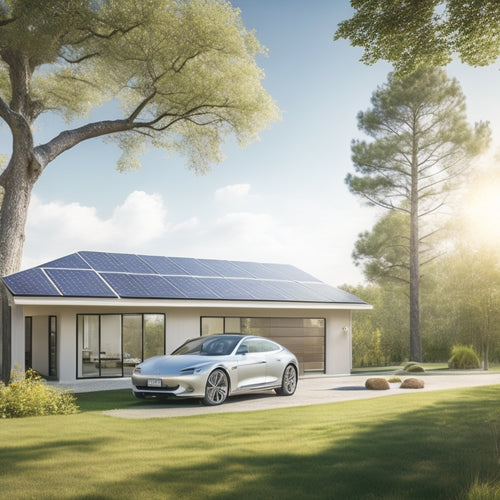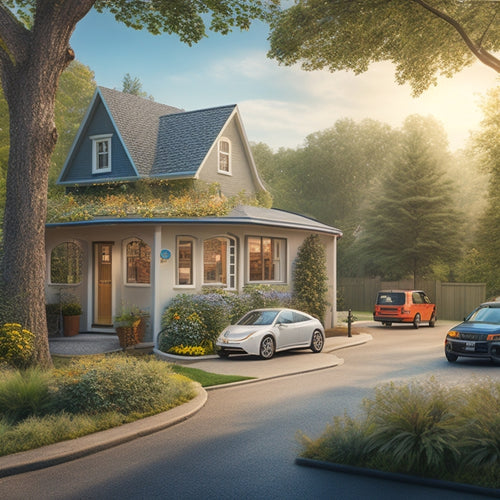
What Is the Average Cost of a Residential Solar System Installation
Share
You'll likely invest between $15,000 and $70,000 in a residential solar system, depending on the system's size, your location, and other factors that influence pricing. The cost per watt, a key metric, ranges from $2.50 to $3.50 for residential systems, with larger systems typically having a lower cost per watt. Labor costs, permitting fees, and component prices also vary, but understanding these elements can help you make an informed decision. As you consider your investment in solar energy, you'll want to investigate how these factors intersect to determine your total system cost.
Key Takeaways
- The average cost of a residential solar system installation ranges from $15,000 to $35,000, depending on system size and location.
- A standard 5-kilowatt system's total cost ranges from $12,500 to $17,500, producing around 6,000 kilowatt-hours (kWh) annually.
- The cost per watt for residential systems averages between $2.50 to $3.50, with larger systems typically having a lower cost per watt.
- Labor costs, permitting, and inspection fees, and component costs contribute to the overall installation cost, with labor costs ranging from $2,000 to $5,000.
- The Federal Solar Investment Tax Credit (ITC) allows homeowners to claim 26% of the total system cost, significantly reducing upfront costs.
Understanding Solar Panel Costs
When reflecting on solar panel installation, understanding the costs involved is essential to making an informed decision. The initial investment can be substantial, but you'll want to weigh it against the long-term savings and benefits.
You'll need to evaluate the total upfront cost of the system, including equipment, installation, and labor. However, you may be eligible for government incentives, such as the Solar Investment Tax Credit (ITC), which can greatly reduce your expenses.
Additionally, many financing options are available, ranging from cash purchases to loans and power purchase agreements (PPAs).
To get a better sense of the costs, you can research the average cost of solar panels per watt, which can vary depending on the system size and quality.
You may also want to factor in additional expenses, such as maintenance and monitoring services. By understanding the costs and available incentives, you can make a more informed decision about investing in a residential solar system.
Factors Affecting System Pricing
When you're considering a residential solar system installation, you'll find that the cost varies depending on several key factors.
One vital aspect is the system size, which directly impacts the overall cost - a larger system requires more panels and equipment, increasing the price tag.
Additionally, your location will also influence the pricing, as local market conditions, labor costs, and regional incentives can differ markedly.
System Size Matters
System size is the primary driver of residential solar system installation costs, as it directly impacts the number of solar panels and supporting infrastructure required. The larger the system, the more panels and equipment you'll need, which increases the overall cost.
However, a larger system also means more energy savings and a greater reduction in your carbon footprint.
When determining the ideal system size for your home, you'll want to evaluate your energy usage and the amount of space available for panel installation. A system that's too small won't generate enough energy to meet your needs, while one that's too large will be more expensive than necessary.
You'll want to strike a balance between system size and cost. Look for a system with high solar efficiency to maximize your energy savings. A more efficient system will produce more power per hour of sunlight, reducing the number of panels needed and ultimately saving you money.
Location Impacts Pricing
Your location plays a crucial role in determining the cost of your residential solar system installation.
Regional incentives, such as state or local tax credits, can greatly reduce the upfront cost of your system. In addition, local regulations, like building codes and permitting requirements, can impact the installation process and costs.
Climate considerations, such as the amount of sunlight your area receives, also affect the system's size and cost.
Market competition among installers in your area can drive prices up or down. Installation availability, including the proximity of installers and the availability of skilled labor, can also influence costs.
Moreover, energy rates in your area can impact the savings you'll realize from going solar, which can, in turn, affect the overall cost of the system.
Average Cost per Watt
When evaluating the average cost of a residential solar system, you'll want to contemplate the cost per watt, which is a key metric in understanding system pricing.
As you investigate this aspect, you'll find that system size matters, as larger systems typically have a lower cost per watt.
System Size Matters
Considering your residential solar system installation, understanding the average cost per watt is essential. The size of your system plays a significant role in determining the overall cost. A smaller system with fewer panels will naturally be less expensive than a larger one.
However, larger systems often have a lower cost per watt due to economies of scale.
When evaluating solar system types, such as grid-tied, off-grid, or hybrid systems, the cost per watt varies. For instance, a grid-tied system typically has a lower cost per watt than an off-grid system with energy storage. This is because energy storage components, like batteries, add to the overall cost.
To give you a better idea, the average cost per watt for a residential solar system ranges from $2.50 to $3.50.
Cost Breakdown Analysis
Five key components typically make up the average cost per watt of a residential solar system: the solar panels themselves, inverters, mounting and tracking equipment, electrical infrastructure, and installation labor.
You'll find that the cost of solar panels accounts for about 40% of the total cost, with the remaining 60% split among the other components.
When breaking down the cost per watt, you'll typically pay around $2.50 to $3.50 per watt, depending on the system size and quality of the components.
For a standard 5-kilowatt system, this translates to a total cost of $12,500 to $17,500.
However, with financing options and tax incentives, the upfront cost can be considerably reduced.
For example, the federal solar investment tax credit (ITC) allows you to claim 26% of the total cost as a tax credit.
Additionally, many states and utilities offer rebates and incentives that can further reduce the cost.
As you investigate your options, be sure to factor in these savings to get an accurate estimate of the cost per watt for your residential solar system.
System Size and Cost
Several key factors influence the cost of a residential solar system installation, and system size is perhaps the most critical one. The larger the system, the more expensive it is. However, a larger system also means more energy savings for you in the long run.
You'll want to determine the right system size for your home based on your energy needs and available roof space. A typical residential solar system ranges from 3 to 10 kilowatts (kW). A 5 kW system, for instance, can produce around 6,000 kilowatt-hours (kWh) of electricity per year, depending on the system efficiency and your location.
This translates to significant energy savings, especially if you consume a lot of power during the day. When determining the ideal system size, consider your energy usage patterns, the size of your roof, and local building codes.
A system that's too small may not generate enough energy, while one that's too large may not be cost-effective. By sizing your system correctly, you can maximize your energy savings and enjoy a faster return on investment.
Installation Costs Breakdown
As you prepare to invest in a residential solar system, understanding the installation costs breakdown is essential for making an informed decision. The overall cost of installation includes various components, and knowing what to expect can help you budget and plan accordingly.
Here's a breakdown of the installation costs:
-
Labor Costs: This includes the cost of hiring a professional solar installer, which can range from $2,000 to $5,000, depending on the complexity of the installation and the installer's experience.
-
Permitting and Inspection Fees: These fees vary by location, but you can expect to pay around $1,000 to $2,000 for permits, inspections, and other regulatory requirements.
-
Financing Options: You may need to evaluate financing options, such as loans or leases, to cover the upfront costs of your solar system. Be sure to factor in interest rates and repayment terms when calculating your total costs.
- Tax Incentives: Don't forget to take advantage of available tax incentives, such as the federal solar investment tax credit (ITC), which can help offset the upfront costs of your solar system.
Inverters and Mounting Hardware
When calculating the overall cost of your residential solar system, you'll need to factor in the inverter and mounting hardware expenses. The inverter is an essential component that converts DC power from your solar panels into AC power for your home.
You'll have to choose from different inverter types, such as string inverters, microinverters, and power optimizers, each with its own advantages and price points. String inverters are the most common, but microinverters and power optimizers offer more flexibility and monitoring capabilities, albeit at a higher cost.
Mounting options also vary, including roof-mounted, ground-mounted, and tracking systems. Roof-mounted systems are the most popular, but ground-mounted systems can be more suitable for homes with limited roof space.
Tracking systems, which adjust to follow the sun's movement, can increase energy output but are typically more expensive. The cost of inverters and mounting hardware can range from $2,000 to $5,000 or more, depending on the type and quality of the components.
Labor and Permitting Expenses
While the equipment costs of your residential solar system are significant, labor and permitting expenses also play an essential role in the overall installation cost. These expenses can vary depending on several factors, including the complexity of the installation, local labor rates, and permitting challenges.
As you plan your solar installation, consider the following labor and permitting expenses:
-
Installation timeline: The longer the installation takes, the more labor hours are required, increasing the overall cost. A complex installation with multiple roof angles or electrical upgrades can extend the installation timeline.
-
Permitting challenges: Obtaining necessary permits from local authorities can be time-consuming and costly. Delays in permitting can lead to increased labor costs and project timelines.
-
Local labor rates: Labor rates vary by region, with urban areas typically having higher rates than rural areas.
- Inspection and testing: Additional labor costs may be incurred for inspections and testing to verify the system meets local building codes and safety standards.
Total System Cost Range
How much can you expect to pay for a residential solar system installation? The total system cost range varies widely depending on several factors, including the system size, quality of equipment, and installation company.
| System Size (kW) | Total System Cost Range |
|---|---|
| 3-5 kW | $15,000 - $25,000 |
| 5-7 kW | $20,000 - $35,000 |
| 7-10 kW | $25,000 - $45,000 |
| 10-12 kW | $30,000 - $55,000 |
| 12+ kW | $40,000 - $70,000 |
Keep in mind that these prices are only estimates, and your actual cost may be higher or lower. Fortunately, there are financing options and government incentives available to help offset the upfront cost. For instance, the Solar Investment Tax Credit (ITC) allows you to claim a tax credit of 26% of the total system cost. Additionally, many states and utilities offer rebates and incentives for going solar. Be sure to research the options available in your area to maximize your savings.
Frequently Asked Questions
Can I Install Solar Panels on a Metal or Tile Roof?
You can install solar panels on a metal or tile roof, but you'll need to verify solar panel compatibility and consider roof installation considerations, such as structural integrity and waterproofing, to guarantee a secure and efficient installation.
Do Solar Panels Work During Power Outages?
You'll find that solar panels don't provide power during outages, unless you have energy storage, like a battery, which allows you to store excess energy generated during the day, maintaining solar panel efficiency even when the grid is down.
Are There Any Local or State Incentives for Solar Installation?
You're likely to save big, as 43% of US homeowners with solar panels benefit from local incentives! You can claim a federal tax credit of 26% of the total installation cost, and investigate solar rebates offered by your utility company or state government.
How Long Does a Typical Solar Panel System Last?
You can expect your solar panel system to last around 25-30 years, with some panels lasting up to 40 years, as long as you follow recommended maintenance requirements, ensuring a prolonged solar panel lifespan and ideal energy harvesting.
Can I Install Solar Panels Myself to Save Money?
You're considering a DIY solar panel installation to save money, but be aware that DIY solar projects can be complex and may void warranties, so it's essential to weigh the potential cost savings against the risks of improper installation.
Conclusion
You've finally decided to utilize the power of the sun, and now you're wondering how much it'll set you back. Ironically, the cost of going green isn't as high as you think. In fact, the average cost of a residential solar system installation has dropped considerably over the years. After considering all the factors, you can expect to pay between $15,000 and $30,000 for a typical system. That's a small price to pay for energy independence and a clear conscience.
Related Posts
-

Why Invest in Solar Car Battery Chargers Online?
By investing in a solar car battery charger online, you're not only reducing your reliance on fossil fuels but also o...
-

Why Nearby EV Conversion Shops Matter to You
Having a nearby EV conversion shop means you'll experience the benefits of a more personalized, convenient, and susta...
-

Why Cities Need Smart Charging Infrastructure Now
You're about to experience a tidal wave of electric vehicles hitting your city's streets, and it's essential you're p...


